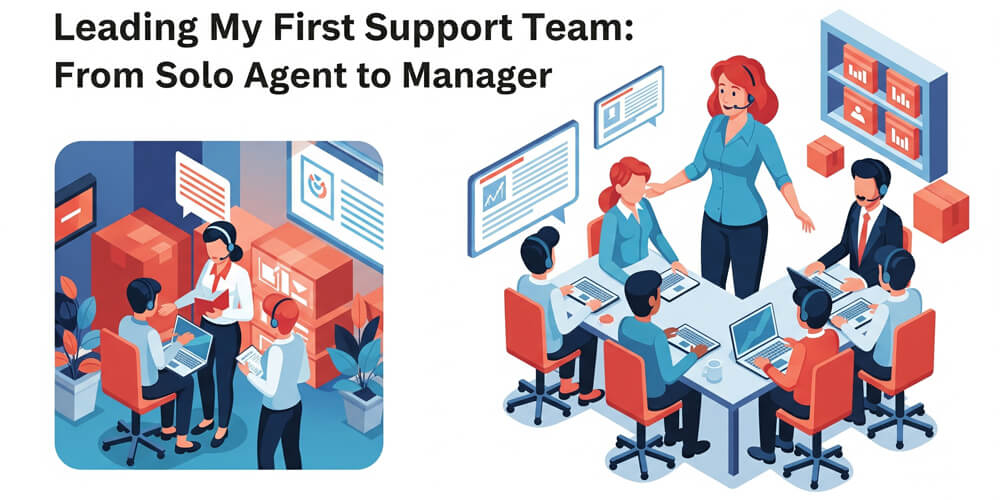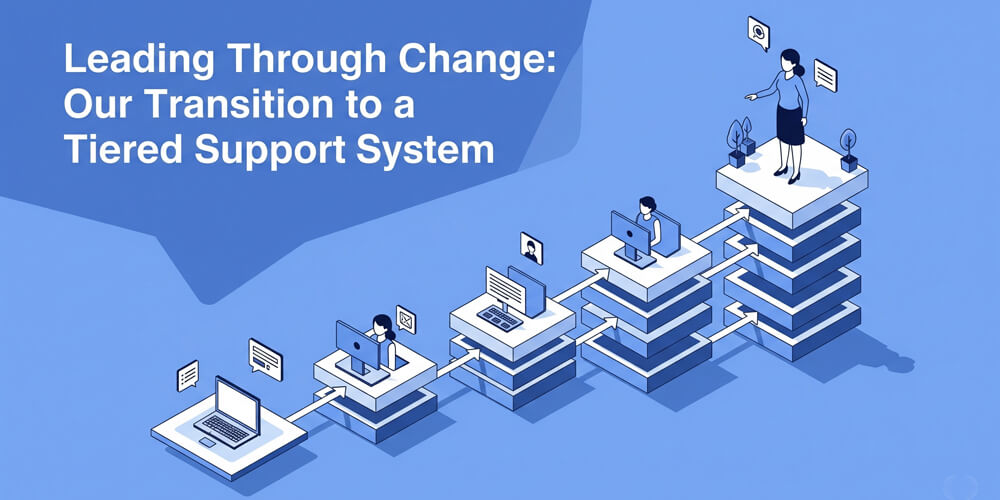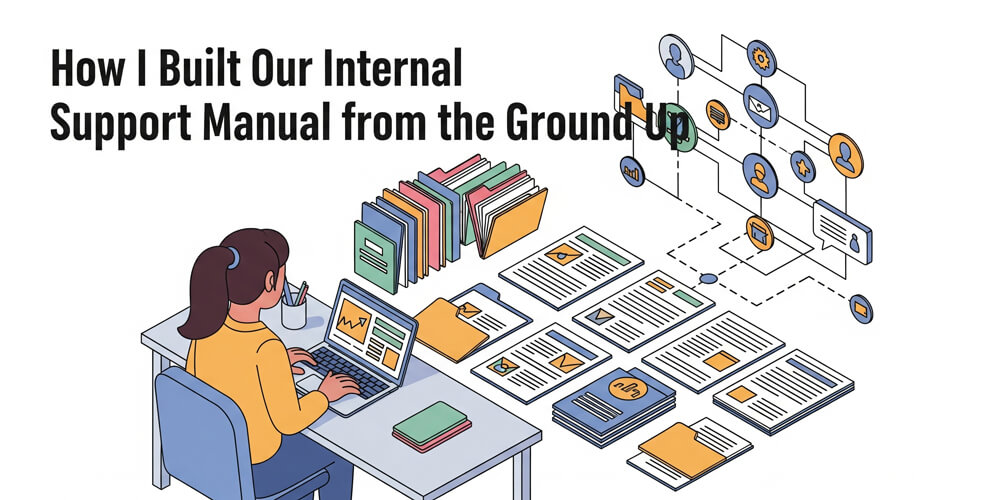The journey from being a hands-on support specialist to leading a team is one of the most challenging yet rewarding transitions in the customer support world. When I joined WPManageNinja in 2022, I was a solo support agent handling multiple products. By April 2024, everything changed when we decided to create product-specific teams, and I found myself tasked with building and leading the support team for our flagship products, FluentCRM and FluentSMTP. This transformation required me to evolve from being the hero who solved most complex tickets to becoming a leader who empowers others to succeed.
What followed was an intensive journey of hiring four new support agents with no WordPress experience, designing a comprehensive three-month training program from scratch, and building a support culture that could handle complex products used by thousands of customers. The process involved countless 12-18 hour days, creating playbooks, establishing quality assurance processes, and ultimately learning to let go of direct control while maintaining high standards. This is the story of how I built a high quality productive support team, the challenges we faced, the lessons we learned, and the systems we put in place to scale support operations while maintaining the personal touch our customers expect.
Table of Contents
Open Table of Contents
- How things started: Undeniable Product Specific Expertise
- The Solo Days: Hitting the Ceiling
- Officially Assigned as the Product Support Lead
- Architecting the Team: Hiring with Heart
- Training Novices into Ninjas
- Letting Go: The Leadership Leap
- Running the Show: Shift Structures
- Final Thoughts
- Me and My Fellow Agents
How things started: Undeniable Product Specific Expertise
It became increasingly clear over time that providing exceptional support required agents to go far beyond surface-level troubleshooting. Our customers weren’t just using our plugins in isolation—they were integrating them with a myriad of other plugins, custom code snippets, and unique workflows tailored to their businesses. Each website was a unique ecosystem, running on different hosting platforms, server environments, and control panels, often with varying versions and configurations. This diversity introduced layers of complexity: a solution that worked for one customer could easily break for another due to subtle differences in their stack.
Support tickets often described issues that spanned multiple plugins, required custom code, or involved integrating with external platforms and APIs. Sometimes, the only way to resolve a customer’s problem was to write bespoke code snippets or debug intricate interactions between plugins and third-party services. In other cases, we had to analyze server logs, trace HTTP requests, or even guide customers through advanced server configurations. The days of “one-size-fits-all” support were over; we needed agents who could think like developers, troubleshoot like sysadmins, and communicate like educators.
After our Annual General Meeting in January 2024, we held a pivotal discussion about the upcoming yearly review and the future of our support operations. By April 2024, it was clear that the old model—where a handful of generalists handled tickets for all products—was no longer sustainable. The complexity and volume of support requests had outgrown what any single agent, no matter how skilled, could handle. We made a strategic decision: to create product-specific teams staffed by true specialists.
Generic support was no longer sufficient—we needed “ninjas” who could dive deep into each product’s ecosystem, understand the technical nuances that made every customer’s setup unique, and deliver the level of expertise our rapidly growing user base expected.
Key points for why we needed product-specific experts:
- FluentCRM’s complexity: As the mother product spawning multiple sub-products (Fluent Forms, Fluent Booking, Fluent Boards, etc.), it required deep understanding of interconnected systems and how changes in one area could ripple across the entire ecosystem.
- Technical depth: Beyond basic WordPress knowledge, agents needed expertise in automation workflows, email deliverability protocols, and complex integrations with third-party services.
- Scale demands: FluentSMTP’s 300,000+ installations required specialists who could handle diverse hosting environments, troubleshoot server-level issues, and adapt to the ever-changing landscape of email infrastructure.
- User expectations: Our growing user base expected sophisticated troubleshooting and proactive guidance, not just generic WordPress support.
- Product evolution: As new features and sub-products were released, it became essential to have agents who understood the entire ecosystem, enabling them to anticipate issues, provide feedback to developers, and support customers through complex migrations and upgrades.
The Solo Days: Hitting the Ceiling
For about 2 years, I was the go-to expert for FluentCRM and FluentSMTP, handling over 5,000 tickets with 12,000+ responses. From debugging cron job failures to optimizing email deliverability for WooCommerce stores, I thrived on solving complex issues. My background—configuring NGINX, troubleshooting PowerMTA for 30 million daily emails, and even hosting WordPress on an Android device for my B.Sc. thesis (GitHub: android-wordpress)—gave me confidence, and I had the expertise and experiences before joining WPManageNinja as I worked as a freelancer for a few years already back then.
But the reality of being a solo agent was both exhilarating and exhausting. Each day brought a new wave of tickets, ranging from simple plugin conflicts to intricate server-level mysteries that demanded deep dives into logs, code, and customer environments. I became adept at context-switching—one moment, I’d be guiding a user through SPF/DKIM records for email deliverability; the next, I’d be writing custom PHP snippets to patch a compatibility issue with email deliveries. My technical toolkit expanded rapidly, and I relished the challenge of being the “fixer” who could untangle even the most convoluted problems.
Yet, as FluentCRM (50,000+ active installs) and FluentSMTP (300,000+ active installs) grew, so did the ticket volume and complexity. The influx wasn’t limited to just these products—other plugins and support agents faced similar surges. The diversity of customer setups meant that no two issues were ever quite the same; what worked for one user could fail spectacularly for another due to subtle differences in hosting, configuration, or plugin ecosystems.
I prided myself on delivering fast, high-quality responses, but the sheer scale became overwhelming. There were days when I’d resolve a critical bug for a major client in the morning, only to find a backlog of urgent tickets waiting by afternoon. The pressure to maintain both speed and depth was relentless. I started to feel the signs of burnout—long hours, mental fatigue, and the creeping realization that, no matter how hard I worked, I couldn’t keep up with the growing demand.
It wasn’t just about technical limits; it was about human ones. The quality of support began to slip, not from lack of effort, but from the impossibility of being everywhere at once. I saw the risk: customer satisfaction could suffer, and the reputation we’d built was at stake. I knew, deep down, that the era of the solo hero was ending. If we wanted to keep delighting customers and supporting our products’ growth, it was time to build a team—to multiply expertise, share the load, and create a sustainable path forward.
Officially Assigned as the Product Support Lead
As someone who had been unofficially focused on FluentCRM and FluentSMTP since 2022, I was entrusted with building the first dedicated support team for our flagship products. What began as a solo journey quickly transformed into a mission to recruit, train, and mentor four complete WordPress novices, turning them into product experts through months of intensive, hands-on learning. The process was grueling—9 to 15 hour days filled with technical deep-dives, documentation, and real-world troubleshooting. Another Tier 2 agent named Ashik was assigned to the product I was leading, and together we set out to build a team culture from the ground up.
The need for product-specific expertise had become undeniable. FluentCRM, as the “mother product” that spawned sub-products like Fluent Forms, Fluent Booking, and Fluent Boards, demanded a level of technical depth that went far beyond WordPress basics. Our agents needed to master complex automation workflows, email deliverability protocols, and the intricacies of integration architectures. FluentSMTP, with over 300,000 active installations at the time, required support engineers who could diagnose SMTP configuration issues, debug mail delivery failures across countless hosting environments, and guide users through advanced server setups. FluentCRM itself was powering over 50,000 business websites, many of which relied on it for mission-critical email marketing, ecommerce automation, and sophisticated business logic.
Architecting the Team: Hiring with Heart
Imagine a master gardener who once tended every plant by hand. As the garden grows, the gardener’s role shifts from watering each flower to cultivating the soil, teaching new gardeners, and designing systems for growth. The beauty of the garden is no longer in a single perfect rose, but in the thriving ecosystem built through shared care and knowledge. Leadership is about nurturing growth in others, not just tending to every need yourself.
Building a team was like assembling a band—each member needed to play their part perfectly. I crafted job posts seeking not just WordPress know-how but curiosity, empathy, and grit. The process was a deep dive into every aspect of team creation:
- Drafting the Job Post: I had to think beyond just a list of technical skills. Yes, I needed people who understood WordPress, but more importantly, I was looking for the core traits of a great support professional: innate curiosity, deep-seated empathy, and a true passion for problem-solving. The job post was actually prepared earlier and it was refreshed for the new hiring. Here is the job post: WPManageNinja is Hiring Technical Support Engineer
- Designing the Exam: I created a technical exam that tested for more than just facts. It included logic puzzles and scenario-based questions designed to see how a candidate thinks, not just what they know.
- Conducting the Interviews: In the interviews, my questions were focused on culture and mindset. I asked about the most difficult customer they’d ever helped, and what they learned from it. I was hiring for resilience and a collaborative spirit.
- Probation Period: Real tickets to simulate our workflow. It was about 3 months long.
But the transition from agent to manager didn’t start with managing—it began with building. I was given the unique and challenging opportunity to hire, train, and mentor four new team members dedicated to our flagship products, FluentCRM and FluentSMTP. This wasn’t just about filling seats; it was about architecting a team from the ground up, with intention and care.
By the end of the process, I wasn’t just onboarding new hires—I was welcoming future mentors, collaborators, and leaders. The foundation was set for a team that could not only handle today’s challenges, but also adapt and excel as our products and customer needs evolved.
Bringing these individuals together was the first real act of leadership: recognizing that the right mix of skills, mindsets, and values would be the engine for everything we hoped to achieve. With the dream team assembled, we were ready to embark on the next phase—transforming raw potential into real-world expertise, and building a support culture that would set a new standard for our company.
Training Novices into Ninjas
Each step was intentional, designed to surface not just technical ability, but the drive to learn and the willingness to support others. I wanted people who would thrive in ambiguity, who could grow alongside our products, and who would contribute to a culture of trust and continuous improvement.
None of my hires knew WordPress initially, so I designed a comprehensive three-month bootcamp that blended theory, hands-on practice, and real-world exposure:
- WordPress 101: We started with daily interactive sessions covering the fundamentals—how themes and plugins interact, the WordPress database structure, email sending mechanisms, and the nuances of different server environments. I encouraged questions and practical experimentation, having each agent set up their own local WordPress site to break and fix.
- Product Deep Dive: Next, we dove into the specifics of FluentCRM and FluentSMTP. Agents learned to build automation workflows, troubleshoot deliverability issues, and understand the logic behind our most complex features. We simulated real customer scenarios, from setting up advanced email sequences to diagnosing why a campaign failed to send.
- Hands-On Practice: After product deep dive, agents tackled troubleshooting drills—debugging plugin conflicts, analyzing logs, and writing custom PHP snippets under supervision. We role-played difficult customer conversations, emphasizing empathy, clarity, and patience.
- Real-World Drills: To cement their learning, I created quizzes, ticket simulations, and surprise “feature pop-quizzes” where agents had to explain a product feature or solve a hypothetical issue on the spot. We reviewed their responses as a group, fostering peer learning and constructive feedback.
The learning curve was steep. Early on, mistakes were common—missed details in logs, misdiagnosed issues, or uncertainty in customer communication. But every misstep became a teaching moment. I encouraged a growth mindset: “It’s okay not to know—what matters is how you find the answer and share it with the team.”
They started by adding internal notes to real tickets, which I reviewed with Ashik, my Tier 2 colleague. We provided detailed feedback, highlighting both technical accuracy and communication style. Over time, their confidence grew. By the end of probation, they were handling live tickets independently, demonstrating not just technical competence but also the empathy and professionalism our customers expect.
The transformation was remarkable: agents who once struggled to install a plugin were now debugging complex automation failures and guiding users through intricate setups. Our training process became a blueprint for future hires, and the team’s collaborative spirit set a new standard for support at WPManageNinja.
Letting Go: The Leadership Leap
The hardest part was stepping back. As a solo agent, I loved cracking tough cases. As a leader, I had to find joy in others’ wins. Watching Sujoy, Arif, and others resolve a high-stakes ticket flawlessly, earning a 5-star review, was my proudest moment. I was astonished to see them working together, sharing knowledge, and supporting each other in ways I never could have imagined. It was a testament to the power of mentorship and the strength of a well-trained team.
I learned that my role was no longer to be the fastest problem-solver, but the best teacher. I had to let go of the urge to jump in and solve every ticket myself. Instead, I focused on empowering my team to take ownership of their work, to trust their instincts, and to know that they had the skills and support to handle even the most complex issues.
The Shift from Doing to Enabling
The most profound change, however, was internal. My definition of a “good day” at work had to evolve. I used to get a rush from personally cracking a complex case that no one else could solve. Now, I find a much deeper and more lasting satisfaction in watching a team member I’ve mentored solve that same complex case, using the framework I taught them.
Letting go is one of the hardest parts of leadership. It’s tempting to jump into a difficult ticket because you know you can solve it quickly. But I learned that my new job wasn’t to be the team’s fastest problem-solver. My job was to be its best teacher. The proudest moment of my year was not a ticket I solved myself, but seeing an agent I had trained from day one handle a high-pressure situation with a major client so flawlessly that they earned a glowing 5-star review. That was success on a completely different level. You may read more about this in my other post: A Team Win That Taught Me an Important Job as a Leader.
This new chapter has been a journey from “doing the work” to “enabling the work of others.” As I wrote recently, leading a team isn’t just about managing tasks; it’s about investing in people and shaping a culture of growth, ownership, and customer happiness. It has been the most challenging, and by far, the most rewarding chapter of my career to date.
One of our first major crises as a new team was a release that caused a critical bug in FluentCRM, impacting a notable amount of users. You would be surprised to learn how the team rallied together to resolve the issue. The same agents who did not know WordPress a few months ago. If you are interested to read more about this, you can read my other post: Handling a Release-Day Crisis Without Losing My Mind.
Running the Show: Shift Structures
As our user base expanded globally, we moved from a standard 9-to-6 schedule to a multi-shift system for better coverage and flexibility. This included day, evening, and weekend shifts, with overlapping hours for seamless handovers and real-time collaboration. Supervisory duties rotated to maintain quality, and we used tools like Discord and Notion to keep everyone connected.
Final Thoughts
Leading my first team was transformative. What’s your leadership story? Share it below or connect on LinkedIn. Let’s inspire each other to build better support teams!
To wrap up, here are a few key lessons from my journey:
- Specialization matters: Product-specific expertise enables deeper problem-solving and better customer outcomes.
- Invest in training: Structured onboarding and continuous learning are essential for building a high-performing team.
- Empower others: True leadership is about enabling your team to succeed, not just solving problems yourself.
- Foster a supportive culture: Psychological safety, open feedback, and shared learning drive growth and resilience.
- Adapt and scale: As your user base grows, evolve your processes and team structure to maintain quality and responsiveness.
Every leadership journey is unique, but the core principles of empathy, growth, and collaboration remain universal. Thank you for reading!




